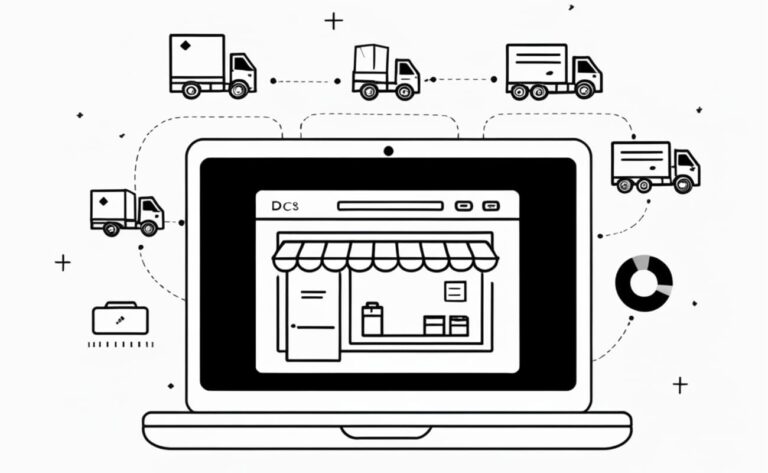If you’ve ever wondered how to transform a simple online idea into a thriving six-figure business, you’ve landed in the right place. In today’s fast-paced e-commerce landscape, a well-crafted dropshipping business plan is the secret weapon every entrepreneur needs. In this comprehensive guide, we’ll delve into the four essential pillars that form the backbone of a successful dropshipping venture: target market analysis, a robust financial model, a reliable supply chain, and a smart operational strategy. Ready to elevate your dropshipping game? Let’s jump right in.
Understanding the Importance of a Dropshipping Business Plan
A strategic business blueprint can make or break your online venture. When you invest the time to create a detailed dropshipping business plan, you’re not only anticipating pitfalls but also leveraging opportunities. Entrepreneurs who take this extra step usually see a higher probability of steady growth, effective risk management, and increased profitability in the long run. The process involves much more than dreaming of success; it requires careful planning, execution, and continuous adaptation to market trends.
For those just starting out, you might also consider checking out our related article on dropshipping jobs for beginners to get further insights into the industry and find inspiration from real-life examples.
The Four Pillars of a Winning Dropshipping Business Plan
The foundation of any robust business lies in understanding the key components that drive its success. When it comes to dropshipping, our strategy focuses on four main pillars:
| Pillar | Description |
|---|---|
| Target Market Analysis | Identifying your niche, analyzing customer behavior, and monitoring trends using tools like Google Trends and Jungle Scout to secure a profitable market segment. |
| Financial Model | Accurate calculation of profit margins factoring in hidden costs such as shipping and returns, forecasting cash flows, and determining your break-even point. |
| Supply Chain | Ensuring quality and reliable suppliers, establishing strict return policies, and managing lead times effectively while adopting risk-reduction strategies like working with multiple vendors. |
| Operational Strategy | Utilizing automation platforms like Oberlo and DSers, and developing a contingency plan to tackle challenges such as shipping delays or unexpected changes in customs regulations. |
1. Target Market Analysis: Knowing Your Audience Inside Out
Before you launch any campaign or start sourcing products, thorough market research is crucial. The first pillar, target market analysis, revolves around understanding who your customers are and what they truly need. This involves identifying a profitable niche by using trend analysis tools such as Google Trends and Jungle Scout – invaluable assets for spotting rising industries and products.
A successful market analysis would cover:
• Assessing competitor strategies, pricing models, and customer engagement levels.
• Evaluating seasonal trends and potential shifts in consumer preferences.
• Identifying underserved segments or emerging needs in the market.
Have you ever wondered what secrets the market holds for your product? Realizing these insights can help you design an exclusive value proposition that attracts, retains, and delights customers.
2. Financial Model: More Than Just Numbers
What’s a business without a reliable financial blueprint? When planning a dropshipping business plan, it is imperative to detail your financial model meticulously. This includes not only calculating profit margins but also anticipating hidden costs like shipping fees, return policies, and unexpected logistical expenses. As you project your revenue streams and cash flows, define what break-even looks like for your specific setup.
Careful financial planning will empower you to allocate budgets effectively and prepare for lean periods without jeopardizing the business. Many entrepreneurs overlook the significance of an emergency fund – or a “rainy day” reserve – while developing the plan. An exemplary financial model will account for:
• Initial start-up costs and recurring expenditures.
• Hidden expenses that might emerge unexpectedly.
• Forecasting monthly cash flows, with an emphasis on the break-even point.
This financial roadmap not only guides your investment decisions but also builds credibility with potential financiers or partners by showcasing your preparedness and strategic vision.
3. Supply Chain: Building a Network of Reliable Partners
In dropshipping, the adage “your business is only as good as your suppliers” holds tremendous truth. Your supply chain is the heartbeat that keeps your business running smoothly. It involves selecting suppliers who maintain high quality standards, possess robust return policies, and can deliver products on time. Entrepreneurs must weigh the risks of working with a single provider against the benefits of diversifying their supplier base.
Key aspects to consider in your supply chain analysis include:
• Quality assurance and supplier accountability.
• Transparent policies on product returns and customer service.
• Strategies to mitigate risks, such as engaging multiple suppliers to avoid stock outages.
Have you considered asking your suppliers about their contingency plans if a product shipment is delayed? Establishing clear communication channels and backup plans is the key to preventing operational hiccups as your business expands.
4. Operational Strategy: Streamlining Your Day-to-Day Execution
The final pillar, operational strategy, is where your vision meets execution. Leveraging automation systems like Oberlo and DSers can streamline inventory management, order processing, and customer service, thereby freeing up your valuable time to focus on scaling your business. A well-articulated plan in this area details how you will manage day-to-day operations, address emergencies, and incorporate technology for efficiency.
Effective strategies in this domain include:
• Integrating automation tools that sync orders directly with your suppliers.
• Establishing a crisis management plan to deal with shipping delays or regulatory changes.
• Regular audits and documentation of operational processes.
Imagine being able to monitor your sales and supplier performance in real time without constantly worrying about manual errors. A streamlined operational workflow not only boosts productivity but also enhances customer satisfaction by ensuring timely delivery and prompt resolution of any issues.

Real-Life Example: From 6-Month Plan to $8,000 Monthly Revenue
Consider the case of an entrepreneur who meticulously drafted a six-month Dropshipping Business Plan. This individual began with a thorough target market analysis, pinpointing a lucrative niche that was gaining momentum on platforms like Google Trends. By leveraging the power of a detailed Dropshipping Business Plan and financial model, they ensured that every dollar was accounted for, while their strategic supplier partnerships reduced operational risks significantly.
Within six months, by harnessing both automated tools and a well-documented operational strategy outlined in their Dropshipping Business Plan, the business was able to generate a stable monthly revenue of $8,000. However, it wasn’t all smooth sailing. Early mistakes such as ignoring end-to-end process documentation and underestimating the need for an emergency fund taught the entrepreneur valuable lessons about risk management and operational sustainability.
Strategies and Best Practices to Avoid Critical Pitfalls
While creating your Dropshipping Business Plan, it is vital to recognize and avoid potential pitfalls that can derail your progress. Many new entrepreneurs fall into the trap of overlooking aspects like hidden shipping costs or failing to maintain process documentation. By understanding what might cause a stumble, you can develop contingencies that ensure smoother operations.
Based on collective industry experiences, here are some thought-provoking tips for your Dropshipping Business Plan:
Regularly re-assess and update your Dropshipping Business Plan, especially as market dynamics change.
Start by documenting every process – from product sourcing to customer service – to create a reference that evolves with your Dropshipping Business Plan.
Always keep a dedicated fund for unforeseen challenges. Not having an emergency reserve can lead to severe operational disruptions in your Dropshipping Business Plan.
Integrating Technology and Human Insights
In a world where technology continuously reshapes e-commerce, remember that human insight remains invaluable. Automation platforms simplify repetitive tasks, yet human oversight is essential to identify trends, develop marketing strategies, and build personal relationships with suppliers and customers. By combining technological efficiency with hands-on management, you create a synergy that propels your business to higher levels of success.
This balanced approach is what sets apart ventures that merely survive from those that truly thrive. So, ask yourself: Are you ready to blend data-driven strategies with your own entrepreneurial passion?
Comparative Analysis: Traditional vs. Dropshipping Business Models
Understanding the differences between conventional business models and dropshipping is critical. While traditional e-commerce might involve significant upfront investment in inventory, dropshipping reduces that burden by passing the inventory management onto your suppliers. Below is a table that contrasts key differences between these models:
| Aspect | Traditional E-commerce | Dropshipping |
|---|---|---|
| Inventory Investment | High upfront costs. | Minimal investment required. |
| Risk of Overstocking | Higher; potential for unsold inventory. | Lower; inventory is managed by suppliers. |
| Operational Complexity | Requires warehouse management and shipping logistics. | Simplified with supplier-managed inventory and shipping. |
| Scalability | Gradual growth, scaling requires more infrastructure. | Quick scaling with proper supplier partnerships and automation. |
This comparison illustrates why many modern e-commerce entrepreneurs are gravitating towards dropshipping – the lower risk and operational simplicity provide an attractive alternative to traditional retail models.

Leveraging Additional Resources to Strengthen Your Plan
While this article aims to provide a comprehensive roadmap, it is important to supplement your knowledge with further resources. For example, exploring a dropshipping business plan template or even a free dropshipping business plan template can give you practical frameworks to build upon. Likewise, reading about a business plan, Shopify can provide insights into integrating e-commerce platforms with your overall strategy.
For additional insights, you might want to read comprehensive guides on industry leaders. A great external resource to explore is the Shopify Dropshipping Guide, which offers in-depth analysis and actionable tips.
Conclusion: Blueprint to Long-Term Success in Dropshipping
In summary, designing a robust dropshipping business plan is a multi-faceted process that demands attention to detail, consistency, and the willingness to adapt. From understanding your target market to developing a financial model that accommodates unforeseen expenses, ensuring a reliable supply chain, and establishing an operational strategy that maximizes efficiency, every element plays a pivotal role.
Reflect on this: how many components of your business are driven by chance, and how many are backed by strategic planning? Real-life examples, like the entrepreneur who built an $8,000 monthly revenue stream within six months, reinforce that diligent planning coupled with agile execution can lead to remarkable success. Remember, the journey might be demanding, but with continuous learning and proactive risk management, the dream of a six-figure income through dropshipping is absolutely within reach.
Frequently Asked Questions (FAQ)
1. What should be included in a dropshipping business plan template?
A comprehensive dropshipping business plan template should cover market analysis, financial projections (including hidden costs and break-even analysis), supplier and supply chain strategy, as well as a detailed operational strategy. It helps to outline your business goals, pinpoint your target audience, and build contingency plans for unexpected disruptions.
2. Where can I find a free dropshipping business plan template?
You can find several free dropshipping business plan templates online by searching for “free dropshipping business plan template.” These resources often provide a structured outline that you can customize according to your niche and operational strategy. Exploring additional resources on reputable e-commerce blogs can also provide guidance on tailoring these templates to fit your specific needs.
3. How does a business plan for Shopify differ from a traditional dropshipping plan?
A business plan for Shopify is typically more tailored towards leveraging Shopify’s built-in tools and features for automation, inventory management, and marketing integration. While the core principles remain similar, such plans emphasize platform-specific strategies and integrations, making it easier to scale your operations seamlessly using Shopify’s ecosystem.
4. How can I ensure my supply chain minimizes risks in dropshipping?
To mitigate risks in your supply chain, always conduct due diligence when selecting suppliers by assessing their quality assurance processes, return policies, and delivery times. Building relationships with multiple suppliers can also ensure continuity in case of disruptions. Detailed documentation and regular performance reviews can further secure your supply chain against sudden challenges.
5. Is it necessary to revise my dropshipping business plan regularly?
Absolutely. The e-commerce landscape is dynamic and influenced by rapidly evolving market trends, consumer behaviors, and regulatory changes. Revising your business plan on a regular basis helps ensure that your strategies remain aligned with current trends and challenges, thereby reinforcing your ability to sustain success in the long run.
By integrating these best practices into your dropshipping strategy, you are better prepared to handle the competitive landscape and pave your way to a successful, six-figure dropshipping business.
For more insights on starting and growing in the world of dropshipping, feel free to explore our homepage at Smarteconomix and continue learning from experts in the field.









